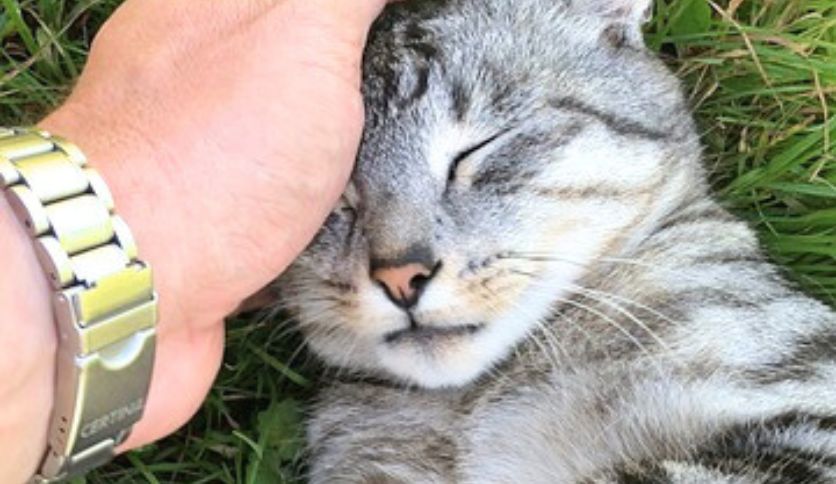Your new cat is adjusting if it displays playful behavior and starts exploring its surroundings. Adjustments in cats can be observed in their grooming and eating habits as well.
Furthermore, you may also notice decreased anxiety signs, such as hiding or excessive meowing, during adjustment periods.
Behavioral Signs Of A Settling Feline
A settling feline will exhibit certain behavioral signs, indicating that they are adjusting to its new environment. One notable sign is a decrease in hiding and an increase in visibility. As they become more comfortable, they will venture out from their hiding spots and spend more time in plain sight.
Another sign is their growing curiosity and exploration. They may start investigating their surroundings, sniffing and pawing at objects to satisfy their natural curiosity. Additionally, a settling cat may play with toys or their human companions. This is a positive indicator that they feel more secure and comfortable in their new surroundings.
Comfort With the Environment And People
If your new cat is seeking affection and is comfortable with petting, it is a sign that they are adjusting well to their new environment. Cats can be cautious when introduced to a new home, but when they start showing signs of wanting attention and enjoy being petted, it indicates that they feel safe and secure.
One of the most important signs that your new cat is adjusting is their consistent use of the litter box. When cats feel comfortable and settled in their surroundings, they naturally use the litter box without issues.
When cats feel safe and secure in their new environment, they often sleep in open, vulnerable positions. This indicates they trust their surroundings and no longer need to be constantly on guard. It’s a positive sign that your cat has adjusted well and feels at ease in their new home.
Indicators Of Feline Contentment

Cats have unique ways of showing their happiness and contentment. One of the signs that your new cat is adjusting well is when they have regular eating and drinking habits. A healthy and content cat will have a consistent appetite and eagerly drink water. Another positive sign is the cat’s vocalizations. Content cats often express their happiness through purring and other content sounds. These sounds indicate that your cat feels safe and comfortable in their environment.
Additionally, a cat that is content will establish a grooming routine. Regular grooming is important for their physical well-being and a way for them to maintain their scent and mark their territory. If you notice that your cat spends time grooming themselves, it is a good indication that they are adjusting well to their new home.
Building Trust With A New Cat
Adjusting to a new environment can be challenging for cats, but some signs indicate they are building trust. Look for small behavioral changes like relaxed body language, increased affection, and playful behavior as signs that your new cat is adjusting and starting to trust you.
Building Trust with a New Cat
|
Shared Moments And Positive Interactions
Your new cat adjusts well if you notice shared moments and positive interactions. These signs indicate that your furry friend is comfortable settling into their new home.
Initiation Of Play Or Cuddles By The Cat
When your new cat starts initiating play or cuddling sessions, it is a clear sign that they are adjusting to their new home and environment. This shows they feel comfortable and secure enough to interact positively. It’s important to nurture these moments and respond enthusiastically, as it helps to strengthen the bond between you and your cat.
Comfort With Handling And Routine Care
Another indication that your new cat is adjusting is their growing comfort with handling and routine care. If they let you pick them up, groom them, or clean their litter box without showing signs of distress, it demonstrates that they trust you and have become familiar with these regular activities. This comfort level is an encouraging sign of their transition into a happy and well-adapted household member.
Signals Of Trust: Exposing Belly, Slow Blinks
Observe your cat’s body language for signals of trust, such as exposing their belly or giving you slow blinks. When a cat exposes their belly, they feel safe and vulnerable around you, as the belly is sensitive. Slow blinks are a display of relaxation and affection. These gestures indicate that your cat feels at ease in your presence and forms a strong bond with you.
Monitoring Your Cat’s Progress
| Monitoring Your Cat’s Progress |
| Consistent behavior patterns over time |
| When bringing a new cat into your household, monitoring their progress and ensuring they adjust well to their new environment is essential. One sign of successful adjustment is the development of consistent behavior patterns over time. Your new cat may start exhibiting certain habits or routines, such as sleeping in a particular spot or using a specific litter box. These consistent behaviors indicate they are becoming more comfortable and secure in their surroundings. |
| Adaptation to household routines |
| Another sign of a well-adjusted cat is their ability to adapt to your household routines. Cats are creatures of habit, so if your new fur baby starts following your daily routines and schedules, it indicates that they are getting accustomed to their new home. They may anticipate meal times, playtime, or even snuggle time. This adaptation to household routines demonstrates their growing trust and familiarity with their environment. |
| Showing preference for certain family members or spaces |
| As your new cat continues to settle in, you may notice them showing a preference for certain family members or spaces in your home. They might seek out specific individuals for affection or companionship, indicating a bond forming. Similarly, if they start claiming certain areas or rooms as their own, such as curling up in a particular chair or perch, it signifies a sense of ownership and comfort. This preference for specific family members or spaces is a positive sign of your new cat’s adjustment and integration into your household. |
Frequently Asked Questions Of Signs Your New Cat Is Adjusting
How Long Does It Take For A Cat To Adjust To A New Owner?
A cat typically takes 2 to 3 weeks to adjust to a new owner’s home. They need time to familiarize themselves with their new environment and build trust with their owner. Patience and consistency in providing a safe and comfortable space can help speed the adjustment process.
How Do I Know If My Cat Is Happy In A New Home?
Observing their behavior lets you tell if your cat is happy in a new home. Look for signs like purring, relaxed body language, playful behavior, and showing affection. A content and well-fed cat is also a good indication of their happiness.
How Do You Know If New Cats Are Getting Along?
Observe their behavior and body language, such as playing together or grooming each other. Look for signs of aggression like hissing and fighting. Monitor their eating habits and ensure everyone has their resources. Gradually introduce them and provide separate spaces if needed.
Seek professional advice if problems persist.
How Do You Tell If Your Cat Will Accept A New Cat?
Observe their behavior to assess if your cat will accept a new one. Introduce them slowly, using scent swapping and controlled meetings. Watch for relaxed body language, no hissing or growling, and positive interactions. Give them time to adjust. Seek professional advice if needed.
Conclusion
Seeing your new cat settling in and adjusting to their new home is lovely. Watch for signs such as increased playfulness, grooming themselves, and confidently exploring their surroundings. These are all positive indicators that your feline friend feels comfortable and secure.
Remember that patience and understanding are crucial in helping your new cat feel safe and loved. Building a strong bond takes time, but your cat will continue to adapt and thrive in their new environment with your care and attention.

Hello, this is Frank Swanson, the owner, and operator of Pet Info Hut. I created this website as a way to share my love of pets with the world. I have over 7 years of experience working with animals, and I have a passion for helping people care for their pets. I hope that you find my website useful and informative. Thanks for visiting!

